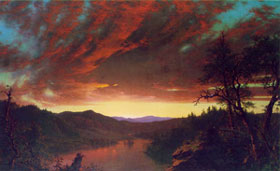日升日落讓我們的地球上有了白天和黑夜。大家都知道太陽的照耀是我們白天有光明的原因。然而,日落后,地球并不是馬上被黑暗覆蓋的。還會有大約一個小時的時間我們能看到、感受到光亮,這又是為什么呢?
 Twilight time: a time of purple clouds, deepening
shadows, a fading glow in the sky. Still light enough to play outside, but
getting harder and harder to read without a lamp. As a song made popular by the
group The Platters in 1958 goes, "Heavenly shades of night are falling; it's
twilight time."
Twilight time: a time of purple clouds, deepening
shadows, a fading glow in the sky. Still light enough to play outside, but
getting harder and harder to read without a lamp. As a song made popular by the
group The Platters in 1958 goes, "Heavenly shades of night are falling; it's
twilight time."
Twilight usually refers to the time just after the sun sets in the evening.
But it also can mean the time just before the sun rises in the morning. During
twilight, although the sun is hidden below the horizon, the sky is still aglow
with light, gradually dimming (after sunset) or intensifying (before sunrise).
During twilight, the light for our evening activities comes courtesy of the
upper atmosphere.
Circling in a plane at sunset, you can see the sun (and bask in its light)
for much longer than if you were on the ground below. It's the same for the
atmosphere. Light rays from below the horizon strike the upper atmosphere. The
light is refracted (bent) as it passes through air molecules, as well as
scattered every which way. The softly illuminated sky creates the twilight, an
hour or so of afterglow before night sets in.
In fact, there are actually four categories of twilight. During the evening,
it all starts with sunset itself, ending when the Sun has just dipped below the
horizon. That's "sunset twilight."
Next comes "civil twilight." During civil twilight it is still light enough
to carry on most outdoor activities, like playing tag on the lawn or watering a
garden. Big shapes are still visible during this early twilight, even without
street lamps or porch lights lit. You may see a few bright stars or planets in
the sky. In the continental U.S., civil twilight lasts for about 30 to 60
minutes, depending on the time of the year (evening twilight is longest in the
summer) and the location. It ends when the sun is about 6 degrees below the
horizon.
Then there's "nautical twilight." During nautical twilight, the sky is dark
enough that all the brighter stars are visible. However, someone at sea could
still sea the horizon well enough to navigate by star altitudes. By the end of
nautical twilight, the Sun has sunk to 12 degrees below the horizon, and the
horizon is no longer visible at sea.
Finally, there's "astronomical twilight." More and more stars can be seen,
but the sky is still too light for an astronomer to do any serious work. When
the sun has dipped to 18 degrees below the horizon, twilight is officially over.
Official "astronomical darkness" has begun.
Unfortunately for astronomers, astronomical twilight lasts all night long
during the summer in place above 49 degrees latitude. And in winter, it's
twilight at noon for people living in far north latitudes.
(來源:how-come.net 英語點津 Annabel 編輯)